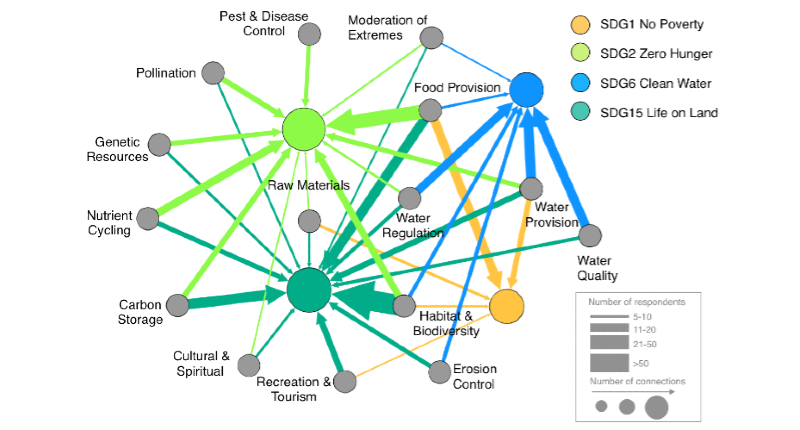Figure for Thought: Making Nature Count in Decisions for Sustainable Development

Ending global poverty and hunger, ensuring clean water and clean energy for all, and protecting nature and human prosperity – the United Nation’s Sustainable Development Goals (SDGs) are laudable, if not easy. Fortunately, a team of researchers from the Science for Nature and People Partnership (SNAPP) have developed a new framework that could enhance efforts to achieve SDG targets by the 2030 deadline: by capitalizing on the benefits nature provides people.
Managing landscapes to maintain or improve their ability to deliver these natural benefits, also called ecosystem services, could help countries advance their progress toward the Global Goals, the team argues. The enhancement of four ecosystem services in particular – food provision, water provision, biodiversity, and carbon storage – could boost sustainable development pursuits, especially when paired with sound technological and policy solutions.
To arrive at this conclusion, the team synthesized input from over 290 experts from the realms of ecosystem science and development policy on nature’s role in supporting the attainment of specific SDG targets. They also evaluated the capacity of existing modeling tools to help policy planning by assessing the models’ capabilities in estimating impacts of management decisions on the supply of ecosystem services.
They published their findings in the February 2018 issue of the journal Ecosystem Services, a paper they say sets a starting point for considering ecosystem services in SDG decisions and strategies. Lead author Sylvia Wood, who was a postdoctoral fellow at Bioversity International during this research, explains the significance of their message for this month’s Figure for Thought:
The role of nature in supporting our lives, societies, and landscapes is often hard to pin down or quantify, leading us to exclude it from decision-making processes. In our paper, we were motivated to find new, more policy-relevant ways to articulate how ecosystem services from nature contribute to many dimensions of human well-being.
Because of their holistic nature and universality, the Sustainable Development Goals offer a coherent framework in which to identify the relationships between nature and measures of well-being embodied by the targets. By mapping where and which ecosystem services could help to achieve these targets, we provide a road map to policy-makers of how nature is essential to, and can support, development efforts.
Here [see Figure 4 above] we show the web of potential contributions of ecosystem services, identified by experts, to targets of SDGs on food, water, poverty, and ecosystems. Importantly, this work makes clear the strong inter-dependence of goals on the provision of multiple ecosystem services. Understanding how ecosystem services contribute to, but also trade-off between goals, is important for designing development robust policies.
We hope this approach will help to make clear the central and broad role of nature in supporting human well-being and provide a new means to bring it more centrally into decision-making processes.
Figure for Thought features thought-provoking, NCEAS-related figures from the academic literature with a brief explanation from the lead author.
